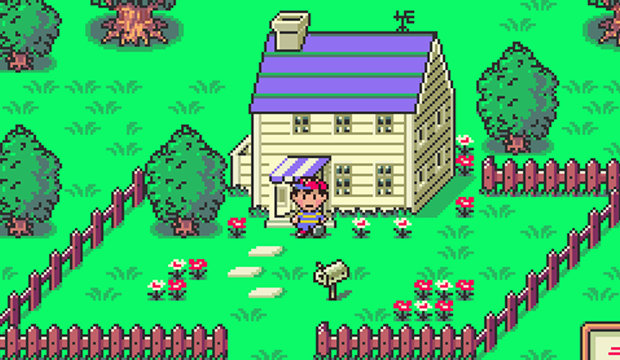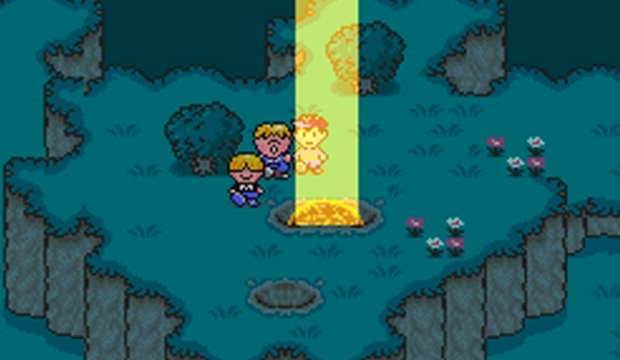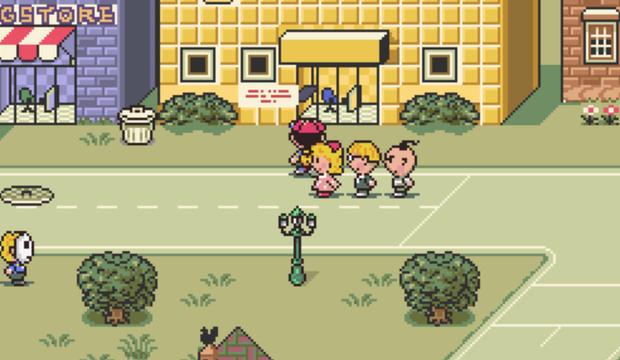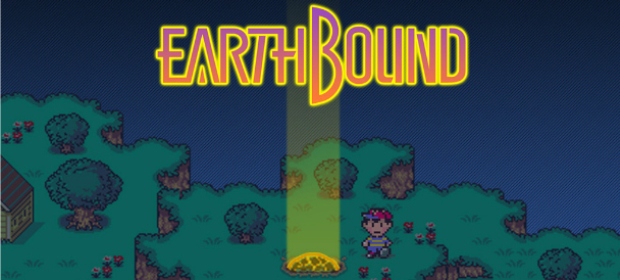There are many reasons why the Super Nintendo is held in such high regard amongst gamers: the ageless first party classics, the groundbreaking Street Fighter II conversions, and the never-forgotten thrill of seeing Mode 7 for the first time. It’s also a hotbed of role-playing games, with some cast-in-stone blinders released over the course of its existence: Final Fantasy, Super Mario RPG, Terranigma, the astonishing Chrono Trigger… and Earthbound. A good indicator of what a classic we have on our hands here is what the blighter still sells for on popular auction sites. Only ever released in Japan and the United States in 1995, until now the only ways for PAL gamers to legitimately sample its delights were a convertor and a hefty sum of PayPal funds. The series known as Mother in Japan has been unattainable to a huge number of gamers for a criminally long period of time, and so this excellent Wii U conversion is more than worth the wait.
A JRPG at its fundamental core, Earthbound spins a cracking, highly unique yarn thanks to the setting and characters, which are completely at odds with the genre and indeed the homeland of Ape and HAL Laboratories, the brains behind the whole deal. You take control of Ness (or whatever name you choose to give your main dude), a superb 8-bit creation, a vision in a stripy top, oversized head and signature baseball cap. The fantastical settings you may associate with a role player are eschewed – to begin with, anyway – as you find yourself in the middle of a small town that is the embodiment of suburban Americana. After an encounter with a fallen meteorite and an alien bee (stick with us, here!), you learn that young Ness is far more than a run of the mill schoolboy growing up in 1990’s Hicksville, USA. He is in fact a gifted chap with hitherto undiscovered psychic abilities, who is destined, along with his gang of friends (and loveable hound), to enter into a battle for the ages with a powerful and more-than-likely psychotic alien fiend – the evil Giygas.

The plot is as sophisticated as you will encounter in the pantheon of role-playing greats, with perhaps one of the best localisation jobs in the history of gaming. It is borne from the supremely creative mind of Shigesato Itoi, a personal hero of your correspondence, who is a distinguished essayist, played the role of Tatsuo in My Neighbor Totoro, and poured his heart and soul, as well as real-life emotional experiences, into crafting Ness’ epic tale. The way it works to a climax and ends will stay with you for as long as you play games, such is its brilliance. Itoi has written about the life experiences that fed into his writing on the game elsewhere, and it makes for a fascinating read if you have the time.
Earthbound’s art style is also unusual: a colourful, crisp mixture of Famicom-esque sprites and beautiful SNES-powered clout, a supreme isometric treat with some clever use of oblique projection. It is another fine example of how well the 16-bit era has aged when compared to the polygons- and 3D-obsessed period that followed. Whether you are playing on your big screen TV or on the Gamepad, this is a lovely looking game. Back in the day, the amount of data packed in, in terms of graphics and sound, meant Earthbound was housed in a 24mb cartridge, which in the States was in turn sold in a monster-sized box (think Super Metroid, PAL fans). Part of the reason for the huge amount of memory (for the time) is the staggering amount of music on the OST.
It isn’t every day you hear a bunch of Japanese videogame composers cite influences as diverse as the Beach Boys, dub pioneer Yabby U and My Bloody Valentine, particularly when one of them was the fella that scored Duck Hunt and Super Mario Land, but that is what occurs here. Earthbound has one of the most ridiculously fine and undeniably “out there” soundtracks that you will ever hear. How some of it managed to remain here in its original form is equally surprising – although there are no overt samples or accreditation, you will hear snippets of familiar tunes from the likes of The Who, Ric Ocasek, and most notably the Beatles. It is thrilling, and sounds bloody fantastic in stereo on the Wii U gamepad.

Playing Earthbound is a delight. You spend an inordinate amount of time chatting to NPCs and exploring, which is fun in itself given the wonderfully strange nature of it all and razor-sharp writing. RPG staples like save points, currency, potions and healing are handled in keeping with the modern setting – you telephone your dad to save your game, draw money out of a cashpoint, get fixed up at a hospital and eat conventional snack items and junk food to restore energy. The battles, however, are quite unlike anything you are used to.
Enemies are visible on the main screen and will usually attack aggressively when you are in range. Like the Paper Mario role-players, you can gain an advantage by approaching foes and gaining the upper hand on them with a pre-emptive strike, which can even kill the foe in one hit if you are more powerful than they are. You then get whisked away to the battle screen, where you and your party members can attack using weapons, items or PP-point-draining “PSI” powers (taking the place of magic), each player carrying out their commands in turn, until either the enemy or the party’s HP runs down to zero. Attacks and damage sustained are described in a comical fashion in a ticker that talks you through the action. Defeating enemies can result in item drops, and bosses need to be taken down to progress the story. The further you proceed, the more powerful your PSI powers become, and you get your hands on weapons infinitely more powerful than the knackered baseball bat you begin with.
In many ways it is conventional, old-school stuff – the same as you would find in an ancient Final Fantasy or Dragon Quest from the NES days. The brilliant thing that sets Earthbound’s combat aside from the norm is the HP counter, which behaves like an odometer on your car. It rolls down in real-time when you take damage, meaning that if you are quick enough you can heal yourself with a well-timed snack even if an enemy has blasted you with an attack that by rights should have put you on your arse. If you find that juggling party members and attacks and commands a bit too testing, you can select an “auto fight” option which does everything for you, in a logical and functional fashion. When the battle is so humourous and enjoyable as this, that’s something you are not going to want to use too often.

What does the Wii U version do to bring the 18 year old game up to date? Well, the off-screen Gamepad play is a boon, as it often is in other games. There are save states, customisable controls, and a brilliant recreation of the strategy guide that was included in the giant US Earthbound package. Other than that, you don’t really need to mess around with the original – it looks and sounds just as great now as it did when it first dropped.
VERDICT: It isn’t every day that one of the finest games ever created pops up on the eShop, and for less than a tenner, too. For as long as the PlayStation has ruled the gaming universe, role-playing fans the world over have clamoured for this, one of the Holy Grail items of 16-bit lore – and with good reason. It isn’t just a case of rose-tinted glasses either – this is a monstrously fine game that was virtually ignored first time around and not deemed worthy of our attention in the Euro-zone whatsoever. Its slow pace and retro combat may not appeal to those used to the more dynamic role-playing of today, but the brilliant, pop-culture savvy story, wonderful scripting and bonkers soundtrack simply cannot be denied. As essential a purchase as you can make for your Wii U console, this is worth every penny and every one of those achingly long years it took to finally reach us.

SUPERB. This is the mark of greatness, only awarded to games that engage us from start to finish. Titles that score 9/10 will have very few problems or negative issues, and will deliver high quality and value for money across all aspects of their design.





